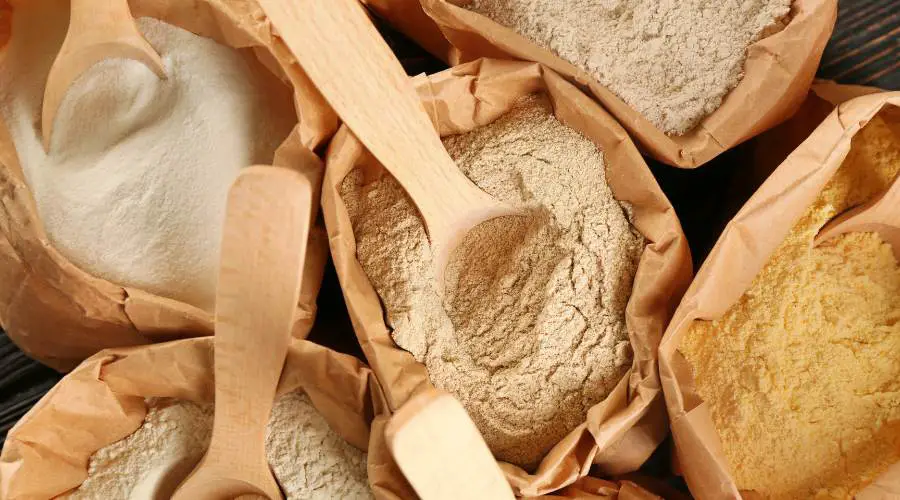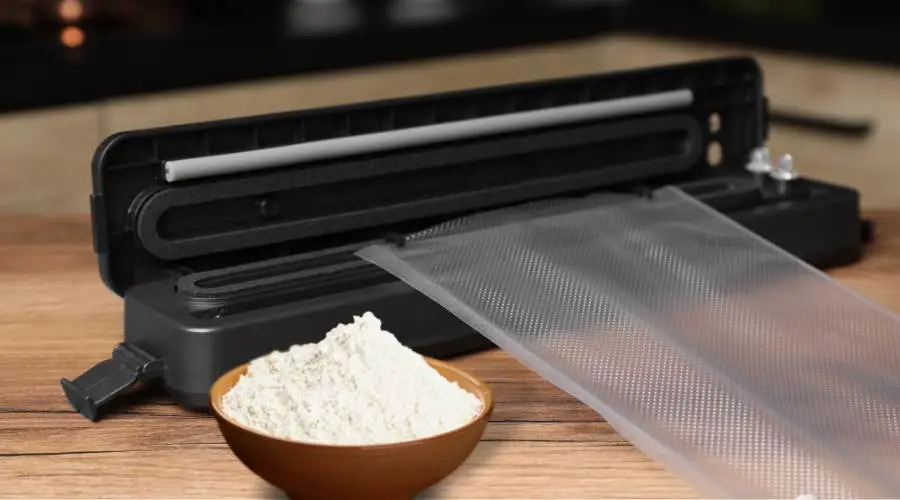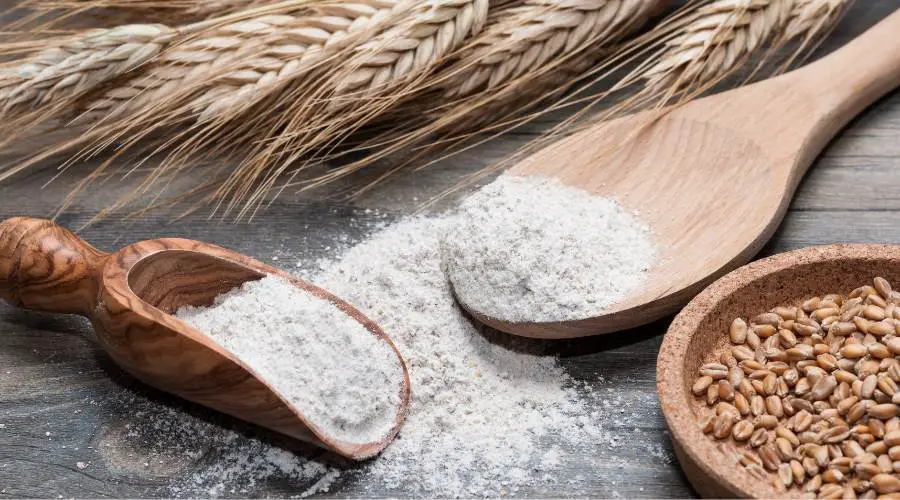Storing flour long-term is an essential part of any household, whether you are a home cook, a professional chef, or a prepper. It’s important to know how to store flour long term to ensure that it stays fresh and safe to use for years to come. As a home cook with years of experience, I understand the importance of proper flour storage and the impact it has on the quality and taste of the final product.
In this article, I will share my knowledge and experience on storing flour long-term, including the types of flours to store, the best way to store flours, the best airtight container for flour storage, whether or not flour goes bad or expires, and how to prevent bugs. By the end of this article, you will have the knowledge and tools you need to ensure that your flour stays fresh and safe to use for years to come.
Types of Grain Flours to Keep Stored
Grain flour is probably the most common type of flour that is made from various types of grains, such as wheat, corn, rye, barley, oats, and others. To make flour yourself you’ll need a grain/flour mill to grind your own flour, see how to select the best grain mill for you and if you’re wondering see if it is actually cheaper to grind your own flour.
Most Common Types of Grain Flour
The most commonly used grain flour is wheat flour, which is made from wheat berries, and corn flour, which is made from ground corn.
There are different types of wheat flours such as all-purpose flour, bread flour, pastry flour, self-raising flour, and whole wheat flour. Each type of wheat flour has a different protein content, which affects the texture and rise of baked goods.
Other Grain Flours
- Rye flour is made from ground rye berries and is commonly used in bread making.
- Barley flour is made from ground barley and is high in fiber, protein, and minerals.
- Oat flour is made from ground oats and is commonly used as a gluten-free alternative.
- Buckwheat flour is made from ground buckwheat and is a gluten-free alternative.
In summary, grain flours are flours that are made from various types of grains like wheat, corn, rye, barley, oats, etc. Each type has its own unique flavor and nutritional properties and can be used in baking a variety of recipes, from breads and pastries to pancakes and waffles.

White Flour
White Flour is a type of wheat flour. It is made from wheat berries that have had the bran and germ removed, leaving only the endosperm. This process makes it more shelf stable than whole wheat flour, but also results in a lower nutritional content.
It is commonly used in baking, such as making bread, pastries, and cakes. The white flour that is most commonly found in grocery stores is all-purpose flour which is a blend of hard and soft wheat and can be used in a wide range of recipes.
Whole Wheat Flour
Whole wheat flour is a type of flour made from the entire wheat kernel, including the bran, germ, and endosperm. Unlike white flour, which is made from just the endosperm, whole wheat flour retains all the natural nutrients and fibers of the wheat kernel. It has a darker color, a coarser texture, and a stronger, nuttier flavor than white flour.
Whole wheat flour is a good source of fiber, vitamins, and minerals, it is typically used in breads, pancakes, and other baked goods. It also has a shorter shelf life than white flour as it contains oil from the wheat germ that can go rancid over time.
How to Store Flour Long Term (for Years)
Storing flour properly is key to ensuring that it stays fresh and safe to use for years to come. According to specialists (see USDA) storing food for the longest time is best achieved in a cool, dry, and dark place with low oxygen.
Conditions to Store Flour
Here are the best tips for storing flour long-term:
- Cool and dry storage location: The ideal storage location for flour is a cool, dry place with a consistent temperature. Avoid storing flour in damp or humid areas, such as near a sink or in a damp basement. A pantry or cupboard away from direct sunlight or heat sources is the best place.
- Proper packaging and sealing: To protect the flour from moisture, pests, and other contaminants, it’s important to use airtight containers, vacuum sealed plastic bags, or mylar bags. This will also keep the flour fresh and prevent it from absorbing any unwanted odors.
- Regularly checking for signs of spoilage: Check your flour regularly for any signs of spoilage, such as a musty smell or discoloration. If you notice any of these signs, it’s best to discard the flour.

Storing Flour in the Freezer Long Term
Storing flour in the freezer is an excellent way to extend its shelf life. Here are the steps on how to store flour properly in the freezer:
- First, place the flour in an airtight container or resealable plastic bag. Make sure to remove as much air as possible before sealing the container or bag. This will prevent the flour from absorbing any unwanted odors or moisture.
- Label the container or bag with the date and type of flour. This will help you keep track of when the flour was stored and how long it has been in the freezer.
- Place the container or bag of flour in the freezer. Make sure the container or bag is placed in an area of the freezer that is not too crowded so that the flour has enough space to freeze properly.
- Once the flour is frozen, it can be stored in the freezer for up to two years.
- To use frozen flour, remove it from the freezer and let it thaw at room temperature for about an hour before using it. Do not thaw frozen flour in the microwave or oven, as this can affect the texture and quality of the flour.
- It’s important to note that freezing flour will change the texture of some types of flour and it may not be suitable for some recipes, like cakes or pastries. So, it’s best to check the recipe before using frozen flour.
Keeping flour in the freezer can help to kill bugs, as freezing temperatures can effectively kill any insects or larvae that may be present in the flour. Freezing will also slow down the metabolism of any microorganisms that may be present in the flour, making it less likely that they will multiply and cause spoilage. However, keep in mind that freezing flour that was already infested may not kill all the bugs and their eggs or larvae.
In summary, storing flour in the freezer is an effective way to extend its shelf life. By following these steps, you can ensure that your flour stays fresh and safe to use for up to two years. Keep in mind that freezing flour can change the texture and it may not be suitable for some recipes, so always check the recipe before using frozen flour.
Also, see complete guides on how to store these common types of food storage items:
Best Airtight Container for Flour Storage
Proper packaging and sealing is important to protect the flour from moisture, pests, and other contaminants, and keep it fresh for a long time. Make sure to choose the right airtight container that can be used for flour storage, including plastic containers and mylar bags.

Plastic Containers
Plastic is a popular choice for flour storage because they are lightweight, affordable, and comes in a variety of sizes. Some popular types of plastic containers for flour storage include:
- Food-grade plastic containers with airtight lids, such as Tupperware or Rubbermaid containers. For bulk amounts of flour, food-grade buckets will work with oxygen absorbers, however, we suggest breaking it up into mylar bags first.
- Plastic containers with vacuum-sealed lids or bags that can be sealed using a vacuum sealer, such as those made by FoodSaver. We often vacuum-seal bags of flour and then store the bags in a food-grade bucket. See if a vacuum sealer is worth it for you.
- Plastic bags with zip-top closures, such as resealable food bags. This option is less protective for longer storage but may work well for flour that is actively being used.
When choosing a container size, consider how much flour you need to store and how often you will be using it. For example, if you only use small amounts of flour at a time, a small container or bag would be sufficient. However, if you use large amounts of flour or purchase it in bulk, a larger container or bag would be more appropriate.
Mylar Bags
Mylar bags are a heavy-duty option for flour storage. They are made of a multi-layer material that is resistant to moisture, light, and oxygen, making them an excellent way to keep flour fresh. Mylar bags can be sealed with a heat sealer to create an airtight seal. This, combined with the properties of Mylar material, provides the best protection for your flour and other dry foods.
One of the key benefits of using Mylar bags is that they can be heat-sealed after removing most of the air creating an airtight container. This is particularly important when storing flour and other dry foods, as oxygen is one of the main factors that contribute to spoilage. Oxygen can cause the growth of microorganisms and the oxidation of fats, which can affect the taste, color, and texture of the flour.
To further increase the shelf life and protect your flour, you can use oxygen absorbers in conjunction with Mylar bags (see how to use oxygen absorbers safely in your stored food). Oxygen absorbers are small packets that contain iron powder, which absorbs the oxygen from the air. They are placed inside the Mylar bags before sealing, effectively removing any oxygen present and creating an oxygen-free environment. This can help to prevent spoilage and extend the shelf life of your flour and other dry goods.
Best Food-Grade Bucket
Food-grade,
BPA-free,
Gamma screw-on lids are included making it easy to access
Also, consider these mylar bags (see on Amazon) oxygen absorbers are included. We have used both of these products and have found them to work well together.
Does Flour Go Bad or Expire?
Flour is a pantry staple that has a long shelf life, but it can go bad or expire over time. Understanding how to identify if the flour has gone bad and how long it will last will help you to ensure that you are using safe and fresh flour in your cooking and baking.
Shelf Life of Flour
The shelf life of flour depends on the type of flour (see the shelf of 6 commonly used flours), how it was stored, and how long it’s been opened. All-purpose flour, for example, can last up to one year when stored in a cool, dry place in an airtight container. Whole wheat flour, on the other hand, has a shorter shelf life of 6 to 8 months because it contains oil from the wheat germ that can go rancid.
Signs of Spoilage
There are several signs that can indicate that flour has gone bad and should be discarded. These include:
- Smell: Flour that has gone bad will have a musty or sour smell. If you notice any unusual odors when you open the package, it’s best to discard the flour.
- Discoloration: If the flour has a gray or yellow tinge, it may be spoiled. It should be a uniform color, usually white or cream.
- Bugs: If you notice small black or brown bugs, webbing, or holes in the packaging, the flour may be infested with pests and should be discarded.
- Mold: If you notice any mold growing on the flour, it should be discarded.
- Staleness: Flour that has gone stale will have a dull color and a slightly off smell. To test if your flour is stale, drop a small amount in a cup of water, if it floats, it’s still good, if it sinks, it’s stale.
It’s important to inspect your flour and other dry goods regularly for signs of spoilage or infestation, and discard any that show any signs of spoilage.
Stale Flour
Flour can also become stale, which will not necessarily make you sick, but it will affect the taste and texture of your baked goods. Stale flour can have a dull color and a slightly off smell. To test if your flour is stale, drop a small amount in a cup of water, if it floats, it’s still good, if it sinks, it’s stale.
Self-raising Flour
Self-raising flour is a blend of flour and leavening agents, it has a shorter shelf life than plain flour, usually about 6 months. If you have self-raising flour that’s been open for some time, you can check if it’s still good by mixing a teaspoon of it with a teaspoon of water, if it bubbles, it’s still good.
In summary, flour can go bad or expire over time, it’s important to be aware of the shelf life of the type of flour you’re using, to check for signs of spoilage, to test for staleness, and to discard the flour if it’s no longer safe to use. By paying attention to the shelf life, signs of spoilage, and proper storage, you can ensure that you are using fresh and safe flour in your cooking and baking.

Preventing Bugs
Bugs, such as flour beetles, can infest flour and other dry goods, making them unsafe to use. To prevent bugs from getting into your flour and other dry goods, it’s important to follow these tips:
- Proper storage: Keep your flour and other dry goods in airtight containers or resealable plastic bags. This will prevent bugs from getting in and protect the flour from moisture, which can attract bugs.
- Regular inspection: Inspect your flour and other dry goods regularly for signs of bugs or infestation. Look for small black or brown bugs, webbing, or holes in the packaging. If you find any signs of infestation, discard the affected flour or dry goods immediately.
- Store in a cool, dry place: Bugs thrive in warm, humid environments. To prevent bugs from multiplying, store your flour and other dry goods in a cool, dry place, such as a pantry or kitchen cabinet.
- Keep it clean: Keep your kitchen and pantry clean and free of crumbs and spills. Clean up any spills or crumbs immediately to prevent bugs from being attracted to your food supply area.
- Store in the freezer: Storing flour in the freezer can help to kill bugs, as freezing temperatures can effectively kill any insects or larvae that may be present in the flour. Freezing will also slow down the metabolism of any microorganisms that may be present in the flour, making it less likely that they will multiply and cause spoilage. However, it’s not a foolproof method, and if the flour was already infested, freezing it may not kill all the bugs and their eggs and larvae, and also freezing may not prevent future infestation.
In summary, preventing bugs from getting into your flour and other dry goods is essential to ensure that your food is safe to use. Proper storage, regular inspection, storing in a cool, dry place, keeping it clean, and using freezer storage can prevent bugs from infesting your flour and other dry goods. By following these tips, you can keep your flour fresh and bug-free for a long time.
Conclusion
In conclusion, storing flour long-term can be a tricky task, but with the right techniques and tools, it’s possible to keep your flour fresh and safe for a long time. Proper storage in airtight containers, regular inspection, storing in a cool, dry place, keeping it clean, and using freezer storage can help to prevent bugs from infesting your flour and other dry goods.
If you’re wondering how much food you should be storing, check out our food storage calculator for help planning out how much food to have stockpiled for you and your family.
Additionally, understanding the shelf life and signs of spoilage of the different types of flours will help you to ensure that you are using fresh and safe flour in your cooking and baking. By following the tips outlined in this article, you can ensure that your flour stays fresh and bug-free for years to come. Flour is an essential food category to keep in your items log of foods that you keep in your home storage.



